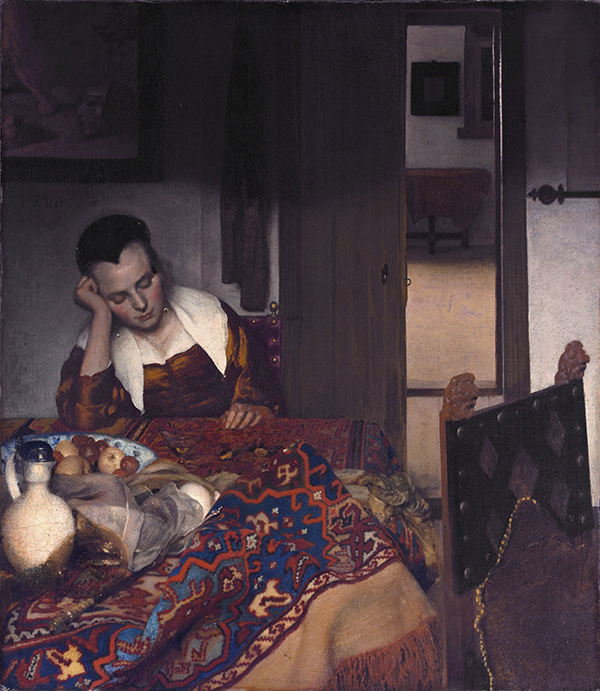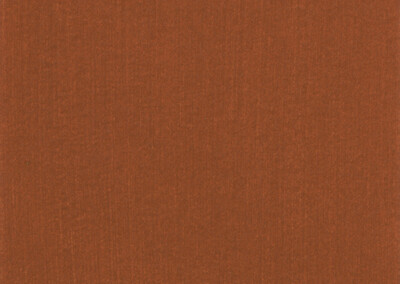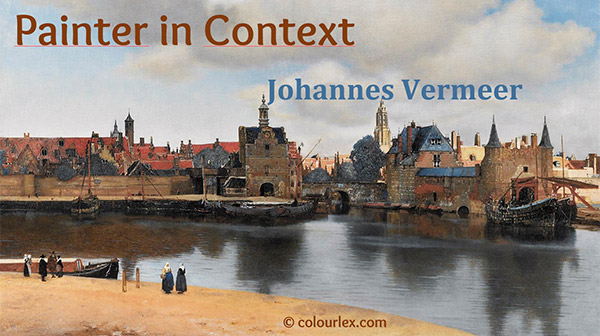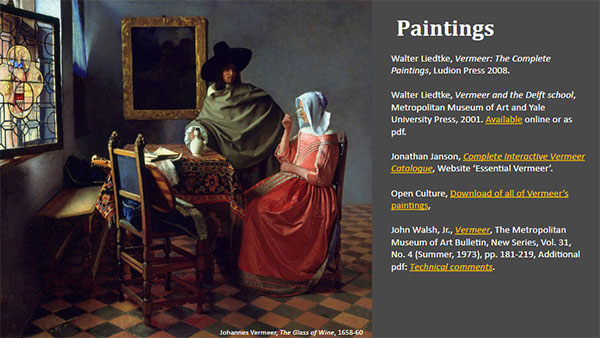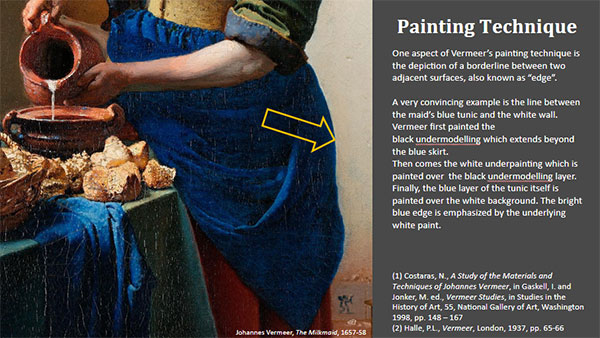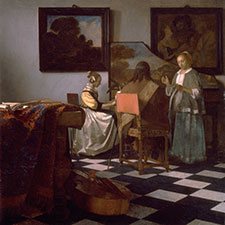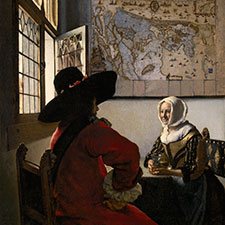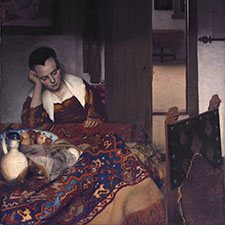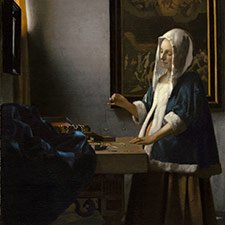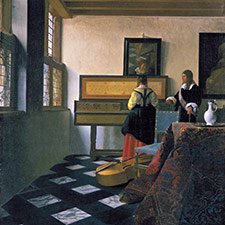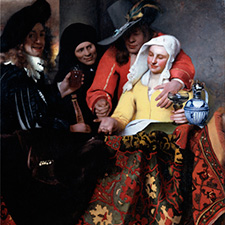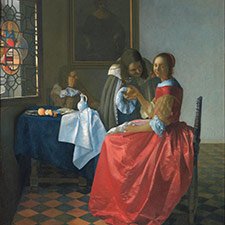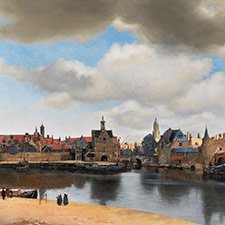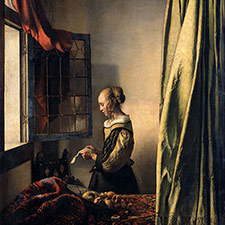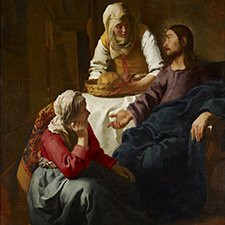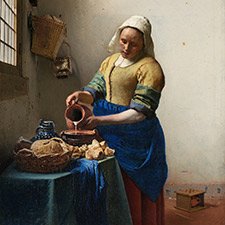Johannes Vermeer, A Maid Asleep
1656-57Paintings sorted by Historical period | Painter | Subject matter | Pigments used
Overview
Medium: Oil
Support: Canvas
Size: 87.6 x 76.5 cm
Art period: Baroque
The Metropolitan Museum of Art New York
Accession Number: 14.40.611
Vermeer, ‘A Maid Asleep’ is most probably the first of Vermeer’s genre paintings depicting a woman or a girl in a household setting.
The pigment analysis revealed a palette consisting of brown, and yellow ochre, lead-tin yellow, natural ultramarine, azurite, smalt, lead white, umber, vermilion, and madder lake.
Pigments
Pigment Analysis
This pigment analysis is based on the work of Hermann Kühn of Doerner Institute in Munich (1) and data compiled in reference (2).
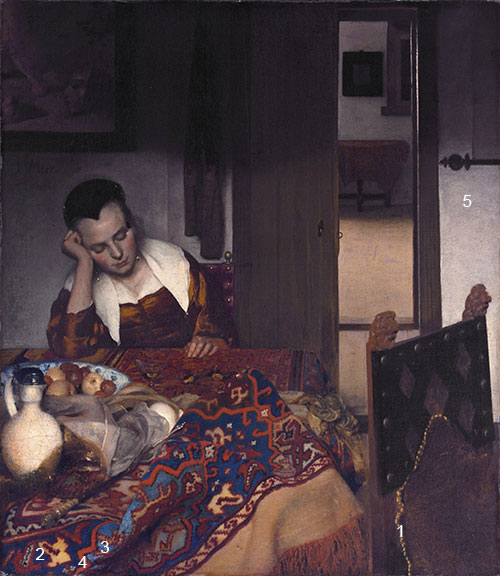
1 Yellow border of the pillow: lead white mixed with lead-tin-yellow.

2 Dark blue area of the carpet: a lower layer containing smalt overpainted with a layer of natural ultramarine.
3 Blue area of the carpet: a lower layer of lead white containing splinters of smalt. The top layer consists of natural ultramarine and small amounts of azurite.
4 Red area of the carpet: The lowest layer consists of lead white mixed with brown ochre, the next layer consists of lead white and vermilion. above these two layers lies another layer of lead white mixed with small amounts of vermilion, a layer of vermilion mixed with a little madder lake and lead white, and finally a dark red layer with madder lake mixed with small amounts vermilion and lead white.
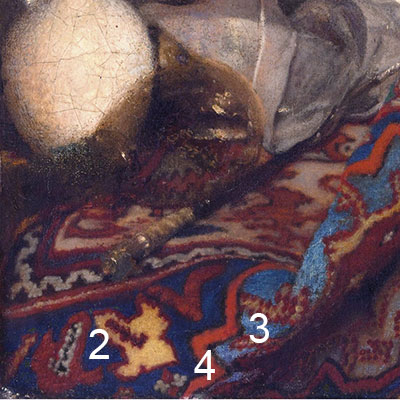
5 Light gray-blue area of the wall: the lowest layer of yellow ochre, a layer of umber, a layer of ochre and azurite, a layer of lead white with grains of azurite and splinters of smalt. The top layer consists of lead white and azurite.

References
(1) Kuhn, H., A Study of the Pigments and the Grounds used by Jan Vermeer, Reports and Studies in the History of Art, National Gallery of Art (Washington, 1968).
(2) Costaras, N., A Study of the Materials and Techniques of Johannes Vermeer, in Gaskell, I. and Jonker, M. ed., Vermeer Studies, in Studies in the History of Art, 55, National Gallery of Art, Washington 1998, pp. 148 – 167
Pigments Used in This Painting
Resources
See the collection of online and offline resources such as books, articles, videos, and websites on Johannes Vermeer in the section ‘Resources on Painters‘
PowerPoint Presentations
Painter in Context: Johannes Vermeer
A richly illustrated presentation on the painting technique and pigments employed by Johannes Vermeer specially crafted for Art Education. (Number of Slides = 24)
- Each presentation starts with the basic resources on the painter such as his biography, main catalogs of his paintings, and a bibliography.
- Next, you find slides describing the painting technique of the artist and the pigments he usually employed in his work.
- The majority of the slides show examples of paintings containing the specific pigments.
Slides showing the basic resources on the paintings of the Dutch Baroque painter Johannes Vermeer.
The painting technique of Johannes Vermeer is described and illustrated in the next slides.
The majority of the slides show important examples of paintings where Vermeer employed specific pigments. The slides are organized according to the color of the pigments.
Publications and Websites
Publications
(1) Madlyn Millner Kahr. “Vermeer’s Girl Asleep.” Metropolitan Museum Journal 6 (1972), pp. 115–132
(2) Gaskell, I. and Jonker, M., Vermeer Studies, in Studies in the History of Art, 55, National Gallery of Art, Washington 1998.
(3) Marjorie E. Wieseman, Wayne Franits & H. Perry Chapman, Vermeer’s Women: Secrets and Silence, Yale University Press 2011.
(4) Salomon, N. From Sexuality to Civility: Vermeer’s Women, in Gaskell, I. and Jonker, M. ed., Vermeer Studies, in Studies in the History of Art, 55, National Gallery of Art, Washington 1998, pp. 309-322.

